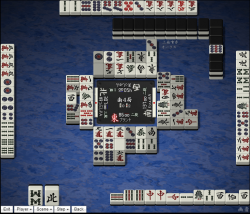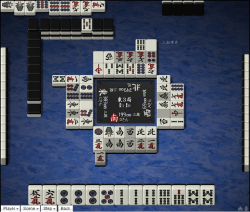Tanki
| Kanji | 単騎 |
|---|---|
| English | Pair wait |
| Fu | 2 fu |
| Tile types waiting | {{{type}}} sided wait |
| Tiles available | 3 tiles |
| Pattern example |
|
| Tenhou.net example |
Tanki 「単騎」 is a common type of wait pattern. Most mahjong hands form to complete the fourth meld. However, a handful of mahjong hands can be formed with four complete melds, while needing to finish the pair. That makes this pattern referred to as the "pair wait". Unlike the other basic patterns, there are a few types of pair waits to consider.
Pattern
The wait pattern involves waiting for a single tile.
Hadaka tanki

Hadaka tanki 「裸単騎」 is a special type of pair wait pattern. A hand in this state has called for discarded tiles four times. Upon doing so, only one tile is left closed in the hand. The yakuman suukantsu always ends up as hadaka tanki at tenpai.
Of all the hand possibilities, hadaka tanki is the weakest position in terms of defending. Only one tile can be exchanged by the draw-discard process. This is due to the static nature of tiles in open calls. The worst case scenario for a hand in hadaka tanki involves both the waiting tile and the drawn tile as winning tiles for another player. In this case, a player has no choice but to play into another player's hand.
Harabote
Harabote 「腹ボテ」 is a type of pair wait, by which the tile is duplicated and used in a sequence. As such, this gives the wait one less tile to wait for compared to a regular tanki, as two are already in the hand.
Chiitoitsu
Every chiitoitsu tenpai hand uses tanki, as the pattern looks to match up the last pair for completion.
Usage

Tanki, or single tile, is best used when seeking to win off of a player's discard. While the number of waiting tiles is limited to a maximum of three, the pattern has its uses. It's greatest strength stems from its ability to select any tile as a waiting tile. Often enough, this pattern may confuse players; and even traps, like suji traps, may be employed. Waits involving honor tiles, especially when one is discarded, is actually powerful, because players may believe those tiles are actually safe tiles. All-in-all, this pattern is best used to counter or bait players, who are looking to defend.
External links
| ||||||||||||||||||||||
